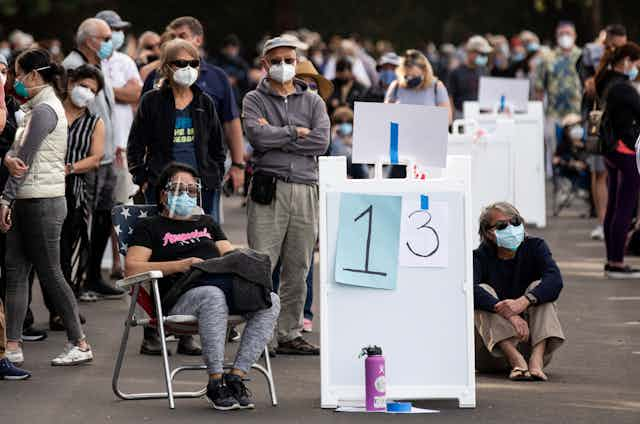“The scientists have done it,” said the UK prime minister, Boris Johnson in December 2020, hailing the development of the new COVID-19 vaccine. Johnson insisted that this success brought “sure and certain knowledge” that people would soon be able to reclaim their lives. But since this optimistic declaration, the COVID vaccine rollout has been beset by challenges.
British GPs were quick to call the process a “shambles”, as delivery delays forced them to cancel appointments and poor communication left them waiting for stock that didn’t arrive on time. In the US, the rollout has been hindered by public confusion, supply shortages, and yet more delays. The federal government failed to achieve its goal of giving 20 million people an initial dose of the vaccine by the end of 2020. By December 31, the number of vaccinated Americans stood at just 2.8 million. By January 8, only 6.68 million had received their first dose.
In several countries where the vaccines have been authorised, criticism is mounting over proposed strategies to stretch supplies. Experts and healthcare professionals have raised concerns about proposals that include administering half doses and extending the time between the two doses.
Some governments have pointed the finger at manufacturers for bottlenecks, while vaccine developers insist it’s an issue of supply. Others cite complications with distribution plans and a shortage of trained staff to administer the shots.
Only 516 people were vaccinated in the first week of France’s campaign and, while Germany has administered over a million doses, its government is still facing criticisms. The Netherlands only started its rollout last week, making it one of the last EU countries to do so.
Misplaced optimism
But these issues have always affected large-scale vaccination rollouts, and we only have ourselves to blame for misplaced optimism. The polio vaccine campaign in 1950s America has assumed a kind of mythological status as a straightforward success – but as a public health professor from Columbia University said, “there was a lot of confusion, there was a lot of chaos, and the federal government was actually widely criticised for its failure to anticipate the public demand for the vaccine”.

The federal government failed to plan or coordinate an effective distribution and relied on an ad hoc selection of pharmaceutical companies for support. They offered little oversight and it was, somewhat unsurprisingly, a disaster. No one knew where to get the vaccine or when they would receive doses – and even doctors had only a limited understanding of the processes involved. And there was the infamous tragedy associated with the Cutter Laboratories, where some batches of the vaccine given to the public contained live poliovirus.
On the other side of the Atlantic, the British Ministry of Health instituted a vaccination programme against polio in 1956, but it too ran into a range of supply and administrative issues. When, just a year later, Coventry experienced an outbreak, it came to symbolise this tragic public health failure.
Both countries saw their vaccine distribution systems repeatedly tested over the second half of the 20th century. In 1976, a strain of influenza emerged in America. Similar problems soon emerged, and the government accelerated a new vaccination programme and more than 400 people who received the jab developed Guillain-Barré syndrome, a rare neurological disorder that can result in paralysis.
The norm
Delays, administrative hurdles, messiness and complexity seem, therefore, to be the norm rather than the exception when it comes to the rollout of vaccines. Why then do politicians still insist on framing the development of new medical technologies as the ultimate quick fix to complex healthcare challenges such as pandemics?
Part of the problem is that the notion that science is an easy cure-all is very appealing. It promotes the work of science and scientists, ties in with attractive and self-satisfying narratives of national progress, and offers the promise of relief in a time of intense global suffering. Politicians, as well as some scientists, have all played their part in promoting this notion.
Histories of science can also perpetuate these narratives. They can gloss over messiness and complexity and paint straightforward stories of “magic bullets” and technological fixes. These stories sell. They provide readers with a comforting sense that science is reliable, morally neutral, and always in aid of the social good.
The real stories are, on the face of it at least, far less comforting. Scientific knowledge is made by people and is subject to their whims and biases. The application of scientific discoveries to challenging healthcare problems is even more complex and even more likely to be waylaid by political needs, special interests and incompetence. But the messiness of medical history can also provide crucial lessons about managing expectations and the value of adaptability.
The history of vaccination programmes makes clear the importance of navigating the many varieties of the human condition and tells us that science cannot be understood separately from society. But just because these programmes have almost always been a shambles does not mean that populations should not hold their governments to account. It just means that we should be extra sceptical of excessive optimism and cautious about rhetoric that frames science as the one and only solution to our collective ills.

